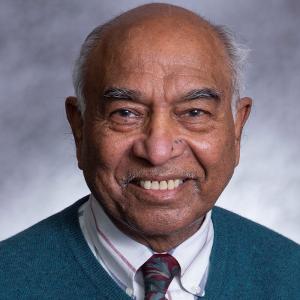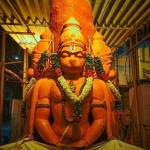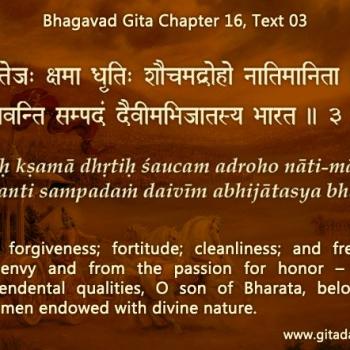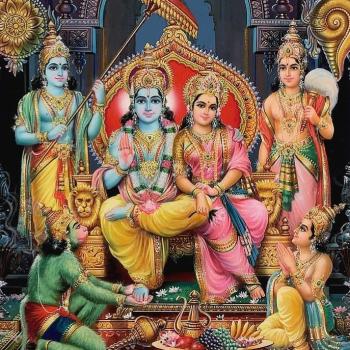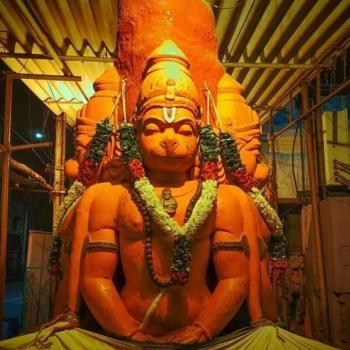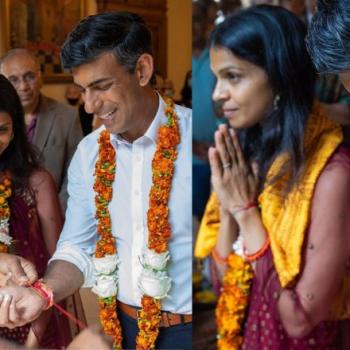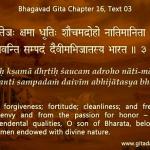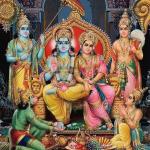HINDU GOD HANUMAN
Hindu God Hanuman Ji (Ji is a sign of respect by Hindus) is part human and part monkey with a long tail. This article is a brief introduction to who Hanuman is and why millions of Hindus worldwide worship Him. The discussion also includes that non-Hindus have faith in the Monkey God, Hanuman.
According to Hindu scriptures, Hanuman is believed to be one of ten incarnations (called das-avatar; ten incarnations) of Lord Shiva. These avatars are thought to have been present in the Satya Yuga (the Golden Age or Age of Truth) when Gods ruled humanity. It is believed that each avatar has a different form and descended on the earth to address a particular issue.
Hanuman’s attributes: Hanuman, the chief among the Monkeys, is a legendary personality. He is worshipped as one of many Bhagwans (God) with extraordinary attributes and abilities. These include his physical strength, loyalty, wisdom, courage, devotion, self-discipline, intelligence-gathering capability, perseverance, presence of mind, and diplomacy.
Hanuman played a critical role in the Hindu epic Ramayana which illustrates the life history of Lord Ram, the seventh incarnation of Lord Vishnu. Lord Ram was also a subject of discussion in an earlier article on Diwali which is celebrated for Lord Ram’s victory over Lanka demon king Ravana. Hanuman performed the task of locating Lord Ram’s wife Sita who was abducted by Ravana and taken to Lanka. In locating Sita, Hanuman showed his ability to fight all obstacles and also served as a diplomat, a topic of discussion in the subsequent article.
WHY HANUMAN JI?
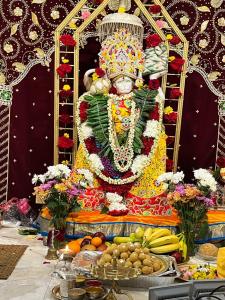
Hanuman Jayanti: The Hindus around the world celebrated Hanuman Jayanti (his birthday) on April 6 as the Christians were getting ready for Good Friday and Easter. I attended it in the local Hindu Temple in Maple Grove, MN, which was the 25th year of the celebration. It included devotional songs and 108 recitations of Hanuman Chalisa, a collection of 40 hymns in praise of Hanuman Ji. Each recitation of Chalisa was followed by proclamations like “Bajrangbali ki Jai”- “victory to thy thunderbolt strength,” and/or “Sri Ramchandra ki Jai’– “victory to Lord Ram.”
Hanuman’s deity is generally part of Hindu temples either as a dedicated mini-temple or a part of Lord Ram’s temple. Hanuman Ji in Maple Grove, MN is shown above.
Most believers of Hanuman ji keep fast and give special offerings on Tuesdays (in some cases, Saturdays) every week. The devotees recite Hanuman Chalisa believing that it removes all obstacles and troubles. Each day of the week is dedicated to a particular God in Hindu tradition and religion.
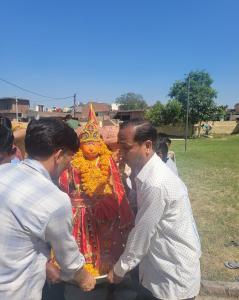
This year, Hanuman Murti (statue) was also consecrated in its mini temple in my village in India after weeklong rituals. The photo on the right shows the ritual in my village, about eight thousand miles from where I currently live.
Giving it a slightly political twist, this year’s Hanuman Jayanti also coincided with the 44th year of the ruling BJP party’s founding day. On this day, India’s Home Minister, Amit Shah, unveiled a 54-foot statue of Lord Hanuman in India’s State of Gujarat.
Lunar Calendar: It is worth noting that Hindu festivals are based on the lunar calendar. For example, the 2024 Hanuman Jayanti will fall on April 24, the full-moon day of the Hindu month of Chaitra (April) at sunrise. Similarly, Lord Ram was born on “Ram Navami,” on the ninth day of the bright half of Chaitra month.
BIRTH OF HANUMAN AND RAM:
According to the legends, Lord Ram’s father, Dasharath, the king of Ayodhya in northern India, was given a bowl of sacred pudding to be shared with his wives. The pudding was blessed to have his wives give birth to divine children including Lord Ram. It is believed that an eagle snatched a portion of the pudding and dropped it where Anjana was meditating. Anjana, a female spirit of the clouds and water, was cursed to be a female monkey until she was blessed to give birth to God’s incarnation.
With Anjana in a state of meditation, the god of wind, Pavana, delivered the sacred pudding into her stretched hands. Anjana consumed it and gave birth to Hanuman. Thus, Pavana became Hanuman’s godfather. Hanuman is also known as Pavana-Putra (son of Pavana) with the ability to fly as fast as the wind.
Anjana’s curse was removed following the birth of Hanuman and she returned to heaven. Before returning, Anjana blessed Hanuman that he would never die. Pavana also conferred boons and blessings on his foster child making him invincible, immortal, and a powerful monkey god.
Thus, Lord Ram and Hanuman were born around the same time when the sacred pudding was consumed by their respective mothers. Lord Ram and Hanuman are the incarnations of Lord Vishnu and Lord Shiva, respectively. The trinity of Hindu divinity includes- Brahma, Vishnu, and Shiva.
Hanuman Jayanti or Janmotsava: Social media created a chatter about whether Hanuman Jayanti should be called Hanuman Janmotsava (birth celebration). The distinction originates from the fact that the “Jayanti” is for persons who are not alive. As stated above, Hanuman’s mother, Anjana, had blessed him to “never die,” Therefore, Hanuman is “ अमर “ (immortal), and thus Hanuman Janmotsav is more appropriate.
HANUMAN TEMPLE IN TAOS (NEW MEXICO):
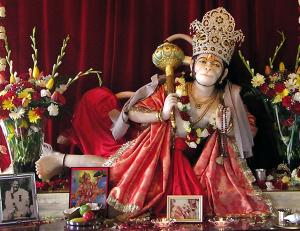
There are numerous Hindu temples with Hanuman ji having a dedicated home in the United States. Of many, most recently, the tallest Hanuman God in the United States found a home in a temple in Delaware in 2020.
The Hanuman Temple in Taos, however, deserves special mention. It is rare of the rarest in the small town of Taos which is literally out of nowhere (we found it accidentally).
This temple depicts Hanuman Ji in his rarest form called “Ramachudamanidayaka.” This form shows Hanuman Ji flying over the ocean to Lanka searching for Sita. This rare form was designed in America, sculpted in Jaipur, India, and transported to His home in Taos. This is probably the only second-flying Hanuman in the world.
The Temple in Taos is built by the disciples of Neem Karoli Baba, a Hindu Guru in India and a steadfast devotee of Lord Hanuman. Baba was the spiritual teacher of many Americans who traveled to India to seek his guidance and blessings.
Reportedly, Baba’s samadhi was visited by Indian Cricketer Virat Kohli in January in Vrindavan, India. In the past, notables like Steve Jobs had traveled to study Hinduism and Indian spirituality. He had planned to meet Baba who, unfortunately, had already died.
Influenced by Jobs, Facebook founder Mark Zuckerberg also visited Baba’s ashram in 2015 when the company was facing tough times.
Hollywood’s Julia Roberts is also said to be influenced by Baba and was drawn to Hinduism because of him.
Hanuman and Ram’s Meeting: According to Ramayana, Lord Ram met Hanuman for the first time when the former was exiled and his wife Sita was abducted. There is another legend that Lord Shiva had planned a meeting between Hanuman and Ram in Ayodhya long before. Lord Shiva as a Madari (monkey puppeteer) and Hanuman as his pet monkey had visited Ayodhya to entertain the then prince Ram and his three brothers.
Is the Monkey God also Chinese? According to a blog, a car accident occurred in front of a tree but no one was hurt. This recent story suggests that with no fatalities in the accident, Hindus attributed it to the power of the Hindu monkey God, Hanuman, in the tree. But, the Buddhists and Taoists believe that the God residing in the tree is Sun Wukong, the Chinese Monkey God. This tree still draws large crowds.
In summary, it will be fair to state that Hanuman Ji is not only a Hindu God. He is omnipresent and His believers include Buddhists and Taoists, and Westerners who take spiritual refuge in Him.
In addition to notables like Jobs, Zuckerberg, and Roberts mentioned earlier, Hanuman Ji offers inspiration to former President Barack Obama. He always carries a Hanuman statuette in his pocket and seeks inspiration when feeling tired or discouraged. The Fast Check found the claim to be true.


